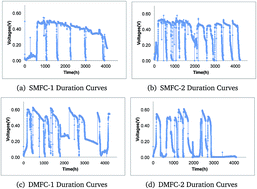Anode biofilm communities and the performance of microbial fuel cells with different reactor configurations
Abstract
The performance and anode biofilm formation of two types of microbial fuel cells (MFCs) were studied in this paper. During 175 days of operation of single-chamber microbial fuel cells (SMFCs), the voltage exceeded 300 mV over 74.9% of the running time and was over 500 mV for 49.3% of the time. For dual-chamber microbial fuel cells (DMFCs), the voltage exceeded 300 mV for 54.3% of the running time and was over 450 mV 50.9% of the time. The removal rate of COD reached 83.6% and 80.0% in the SMFCs and DMFCs, respectively. The maximum power outputs were 686 mW m−2 and 776 mW m−2 for the two types of MFCs during polarization. In this study, the 454 pyrosequencing technique, a massively parallel sequencing technology, was utilized to survey the microbial community of the anode biofilms in different MFC reactors. A variation existed between the biofilm communities of the two MFC anodes. This was presumably caused by different electron acceptors, which affected the extracellular electron transfer speed.


 Please wait while we load your content...
Please wait while we load your content...